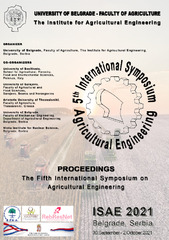Приказ основних података о документу
Reduction of plant weight loss in the process of hay baling using water steam
| dc.creator | Dražić, MIlan | |
| dc.creator | Gligorević, Kosta | |
| dc.creator | Pajić, Miloš | |
| dc.creator | Živković, Milovan | |
| dc.creator | Zlatanović, Ivan | |
| dc.creator | Simonović, Vojislav | |
| dc.creator | Bošković, Biljana | |
| dc.date.accessioned | 2023-03-03T12:45:33Z | |
| dc.date.available | 2023-03-03T12:45:33Z | |
| dc.date.issued | 2021 | |
| dc.identifier.isbn | 978-86-7834-386-5 | |
| dc.identifier.uri | https://machinery.mas.bg.ac.rs/handle/123456789/5032 | |
| dc.description.abstract | Hay is a bulky part of the meal that is most often used in the winter period of the year in all types of ruminants, while the role of hay in the meal of high-milk cows is invaluable. The most common way to produce hay is to dry the cut grass on the surface of the land in the field, using the energy of the sun. In the process of hay production, there is a reduction of nutrients in relation to the green mass, where the achieved yield and quality of hay largely depends on the technological operations that are performed during storage. In the baling process, the dried mass is exposed to the mechanical treatment of the working elements of the press, as a result of which the leaf mass decreases. Loss of leaf mass, which contains a large amount of nutrients, can greatly affect the achieved yield and quality of the obtained hay. One of the possibilities to reduce losses is the application of "DewPoint" technology, which involves the use of water vapor in the baling process. The steam produced by the device is injected into the mass-hay after lifting by the pickup device and further until the mass enters the pressing chamber. Mass treatment is achieved by injecting steam through a series of nozzles located inside the press. Water vapor is an extremely efficient medium for the controlled hydration of hay during the baling process, where approximately 450 l of water vapor can be produced from 1 l of water. By applying this technology, water consumption is 5-7 l per 1 t of hay, producing 2250-3150 l of water vapor. This amount of steam enables efficient treatment of individual plants (tree, leaf) in a mass of 1t to the desired humidity level. | sr |
| dc.language.iso | en | sr |
| dc.publisher | University of Belgrade, Faculty of Agriculture, The Institute for Agricultural Engineering | sr |
| dc.relation | info:eu-repo/grantAgreement/MESTD/Technological Development (TD or TR)/31051/RS// | sr |
| dc.relation | info:eu-repo/grantAgreement/MESTD/inst-2020/200116/RS// | sr |
| dc.rights | openAccess | sr |
| dc.rights.uri | https://creativecommons.org/licenses/by/4.0/ | |
| dc.source | The Fifth International Symposium on Agricultural Engineering - ISAE-2021, Proceedings | sr |
| dc.subject | hay quality | sr |
| dc.subject | baling | sr |
| dc.subject | losses | sr |
| dc.subject | water vapor | sr |
| dc.subject | hydration | sr |
| dc.title | Reduction of plant weight loss in the process of hay baling using water steam | sr |
| dc.type | conferenceObject | sr |
| dc.rights.license | BY | sr |
| dc.rights.holder | Milan Dražić | sr |
| dc.citation.epage | I-73 | |
| dc.citation.rank | M33 | |
| dc.citation.spage | I-63 | |
| dc.identifier.fulltext | http://machinery.mas.bg.ac.rs/bitstream/id/12228/bitstream_12228.pdf | |
| dc.identifier.rcub | https://hdl.handle.net/21.15107/rcub_machinery_5032 | |
| dc.type.version | publishedVersion | sr |


